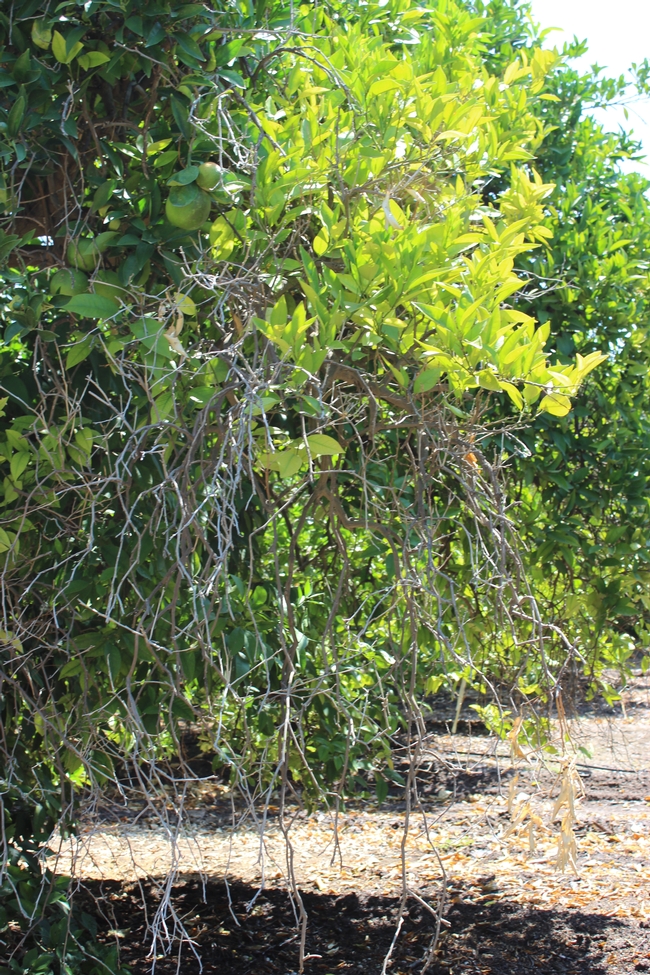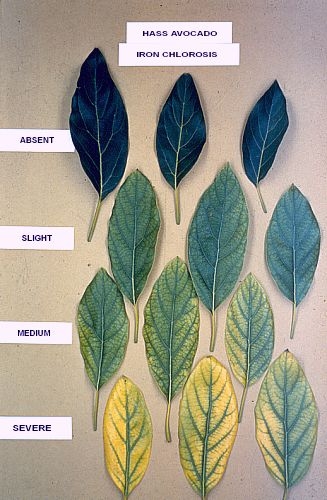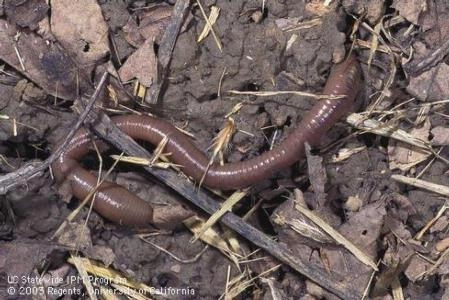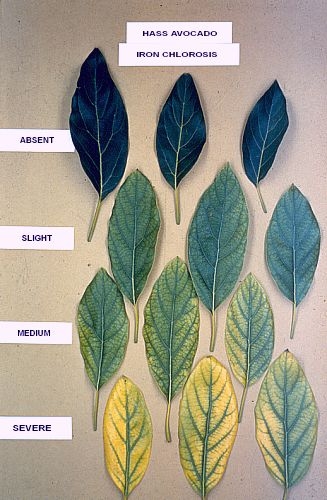
Posts Tagged: ornage
Watch Those New, Yellow Flush Leaves Closely
Lime-induced Iron Chlorosis: a nutritional challenge in the culture of several subtropical perennial crops in California
Elizabeth Fichtner, UCCE Tulare County and Rachel Elkins, UCCE Lake and Mendocino Counties
Spring, and new leaves are coming out, but this could, but yellow could be a sign of iron chlorosis, as well.
Although iron (Fe) is the 4th most abundant element in the lithosphere, Fe deficiency is among the most common plant micronutrient deficiencies. Fe deficiency in plants is common in calcareous soils, waterlogged soils, sandy soils low in total Fe, and in peat and muck soils where organic matter chelates Fe, rendering the element unavailable for plant uptake. In California, lime-induced Fe deficiency is often observed in soils and irrigation water containing free lime, and is exacerbated by conditions that impede soil drainage (ie. compaction, high clay content), resulting in reductive conditions. Given that over 30% of the world's soils are calcareous, lime-induced Fe deficiency is a challenge in numerous perennial cropping systems including: grapes, pears, apple, citrus, avocado, pecans, and stone fruit (prune, almond, apricot, peach, nectarine, cherry).
In most soils, Fe oxides are the common source of Fe for plant nutrition. Solubility of Fe oxides is pH dependant; as pH increases, the free ionic forms of the micronutrient are changed to the hydroxy ions, and finally to the insoluble hydroxides or oxides. In calcareous soils, the bicarbonate ion inhibits mobilization of accumulated Fe from roots to foliage and directly affects availability of Fe in soil by buffering soil pH. When irrigation water is also high in bicarbonate, probability of Fe deficiency is enhanced because bicarbonate is continuously supplied to the soil, and more importantly, the roots may become crusted with lime as water evaporates, thus inhibiting root growth and function. Inside the plant, bicarbonate inhibits nutrient translocation from roots to aboveground plant parts. The adverse effects of high bicarbonate levels are exacerbated in very saturated, very dry, or compact soils, where bicarbonate levels increase concurrent with diminished root growth and nutrient uptake.
Symptoms of Fe deficiency in plants
Fe is immobile in plants; therefore, symptoms appear in young leaves. Interveinal chlorosis (Figure 1) is the main symptom associated with Fe deficiency, followed by reduced shoot and root growth, complete foliar chlorosis, defoliation, shoot dieback, and under severe conditions may result in tree mortality. Overall productivity (yield) is reduced, mainly from a reduced number of fruiting points.
Plant Adaptation
Plant species and cultivars vary in their sensitivity to Fe deficiency, and are categorized as either "Fe-efficient" or "Fe-inefficient". Fe-efficient plants have Fe uptake systems that are switched on under conditions of Fe deficiency. Fe-inefficient plants are unable to respond to Fe deficient conditions. All Fe-efficient plants, except grasses, utilize a Fe-uptake mechanism known as Strategy 1. Strategy 1 plants decrease rhizosphere pH by release of protons, thus increasing Fe solubility. Some plants may excrete organic compounds in the rhizosphere that reduce ferric iron (Fe3+) to the more soluble ferrous (Fe2+) forms or form soluble complexes that maintain Fe in solution. Additionally, roots of Strategy 1 plants have specialized mechanisms for reduction, uptake, and transfer of Fe within the plant. Strategy 2 plants (grasses) produce low molecular weight compounds called phytosiderophores which chelate Fe and take up the chelated Fe with a specific transport system.
Amelioration of Fe chlorosis
Planting sites in calcareous soils should be well drained to provide optimal conditions for root growth and nutrient uptake. Waterlogged and compact soils contain
more carbon dioxide, which reacts with lime to form even more bicarbonate. These conditions, as well as very dry soils, also inhibit microbial activity which aids in
solubilization and chelation of Fe. Prior to planting, soils and water should be tested to determine the pH, lime equivalent, and bicarbonate concentration. Bicarbonate concentrations greater than 3 meq/L in irrigation water increase the hazard of lime accumulation on and around roots. If high bicarbonate water must be used, the pH must be adjusted to 6.0-6.5 to dissolve the bicarbonate and prevent it from negating the effects of soil-based treatments. In microsprinker and drip systems, acidification of irrigation water will also reduce the risk of emitter clogging, a common problem at bicarbonate levels over 2 meq/L. The cost of reducing the pH of irrigation water will more than compensate for the savings incurred from avoiding wasted investment in failed soil- and plant-based remedies. Systems can be set up to continuously and safely inject water with acids such as sulfuric, urea-sulfuric, or phosphoric during irrigations. Specific choice and rate will depend on crop, soil type, other nutrient needs, availability, and cost. Downstream pH meters are available to continuously adjust rate of acid use. Acetic and citric acid can be utilized by organic growers.
Soil based pre-plant treatments to reduce pH include elemental sulfur (S) and acids as mentioned above. It is only necessary to treat a limited area near the root zone to ameliorate symptoms because the tree only needs to take up a small amount of Fe. Material can be shanked in or banded and incorporated in the prospective tree row. One ton of elemental sulfur per treated acre is needed to mitigate three tons of lime, and may need to be re-applied every 3 to 5 years after planting. The addition of organic matter such as well-composted manures will benefit poorly drained or compact soils by increasing aeration for better root growth, fostering chelation of nutrient cations, and reducing pH (depending on source material).
If possible, choose a Fe efficient species or cultivar. In perennial systems, lime-tolerant rootstocks may be the first line of defense in combating Fe deficiency. Some rootstocksmentioned are peach-almond and Krymsk-86 for stone fruit, Gisela 5 for cherry, and Pyrus communis for pear. Ongoing research studies in Europe focus on screening rootstocks of grape and olive for lime tolerance.
Once soil and water quality improvements are made, post-plant management strategies may also be implemented to ameliorate lime-induced Fe chlorosis in the short term. Soil can be acidified as described above. Individual trees can be treated by digging four to six 12-24 inch
holes around the drip line and burying a mixture of sulfur and Fe fertilizer. Historically, two principal methods have been utilized: 1) foliar application of inorganic Fe salts (ie. ferrous sulfate), and 2) soil or foliar application of synthetic chelates. Application of Fe salts to foliage may have mixed results due to limited penetration of Fe into leaves and inadequate mobilization within the plant. Use of Fe chelates may be of benefit; however, they are expensive and pose an environmental concern due to their mobility within the soil profile. Because soil lime interferes with Fe mobility with the plant, repeat application of inorganic Fe salts or Fe chelates may be necessary throughout the growing season.
Choice of nitrogen (N) fertilizer may also influence solubility of rhizosphere Fe. When N is applied in the ammonium form (NH4+), the root releases a proton (H+) to maintain a charge balance, thus reducing rhizosphere pH. Alternately, fertilization with nitrate (NO3-) results in root release of hydroxyl ions (OH-), resulting in an increase in rhizosphere pH. Solubility of Fe3+ increases 1000 fold with each one unit decrease in pH; therefore, fertility-induced rhizosphere pH changes may significantly influence Fe availability.
New methods for amelioration of Fe chlorosis are under investigation. For example, container studies have demonstrated that inter-planting sheep's fescue, a Strategy 2 plant, with a Fe-inefficient grape rootstock may ameliorate Fe chlorosis in grape. In this system, the grass produces a phytosiderophore that enhances Fe availability to the grape. Additionally, soil amendment with Fe3(PO4)2• 8H2O), a synthetic iron(II)-phosphate analogous to the mineral vivianite, has been effective at preventing Fe chlorosis in lemon, pear, olive, kiwi, and peach. Vivianite has a high Fe content (~30%) and serves as a slow release source of Fe in calcareous soils.
Figures below: Shoot dieback in citrus and iron chlorosis in avocado

iron dieback citrus

avocado chlorosis
Earthworms, Soil Productivity, Citrus and Avocado
There are 4,000 species of earthworms grouped into five families and distributed all over the world. Some grow uo to 3 feet long, while others are only a few tenths of inches. We call them nightcrawlers, field worms, manure worms, red worms and some people call them little diggers.
In California, we have some native species of earthworms, but in many cases non-native introduced species have come to dominate. The predominant native species belong to the Argilophilus and Diplocardia while many of the non-native are of European in origin in the Lumbricidae family. Many of these non-natives were probably introduced by settlers bringing plants from home, which had soil containing the worms. A survey of California earthworms by the US Forest Service can be found at:
https://www.fs.fed.us/psw/publications/documents/psw_gtr142/psw_gtr142.pdf
This is a wonderful description of earthworm biology and their occurrence in the landscape.
When digging in citrus orchards, it is common to find earthworms in the wetted mulch under tree canopies. Many of our citrus orchards were initially established by “balled and burlap” nursery trees that brought worms along with the soil. In the case of many avocado orchards, on the other hand, it can be rare to find earthworms in orchards. Most avocado orchards have been established since the 1970s when potting mixes and plastic liners were the standard practice and worms were not part of the planting media. Even though there is a thick leaf mulch in avocado orchards, the worms have not been introduced, and it is rare to find them.
Numerous investigators have pointed out the beneficial effects of earthworms on soil properties. One of the first of these observers was Charles Darwin who published Earthworms and Vegetable Mould in 1881. He remarked on the great quantity of soil the worms can move in a year. He estimated that the earthworms in some of his pastures could form a new layer of soil 7 inches thick in thirty years, or that they brought up about 20 tons of soil per acre, enough to form a layer 0.2-inch-deep each year.
Earthworms, where they flourish, are important agents in mixing the dead surface litter with the main body of the soil. They drag the leaves and other litter down into their burrows where soil microorganisms also begin digesting the material. Some earthworms can burrow as deeply as 5 to 6 feet, but most concentrate in the top 6 to 8 inches of soil.
The worm subsists on organic matter such as leaves and dead roots near the soil surface. The earthworm ingests soil particles along with the organic matter and grinds up the organic matter in a gizzard just as a chicken does. This is excreted in what we call worm casts. The castings differ chemically from the rest of the soil, as they are richer in nitrogen, potassium and other mineral constituents.
Castings are a natural by-product of worms. When added to normal soils in gardens or lawns, they provide the same kinds of benefits as other bulky organic fertilizers. Castings today are not commonly used as fertilizer by commercial plant growers because of their cost relative to other fertilizers. However, castings are used by some organic growers and are sold commercially as a soil amendment or planting medium for ornamental plants grown in pots.
The physical soil churning process also has several important effects:
-Organic residues are more rapidly degraded with the release of elements such as nitrogen, sulfur and other nutrients.
-Some of the inorganic soil minerals tend to be solubilized by the digestive process.
-Extensive burrowing improves soil aeration.
-Burrowing can improve water penetration into soils
-The earthworm carries surface nutrients from the soil surface and imports them into the root zone of the plant.
Although earthworms are considered beneficial to soil productivity, few valid studies have been made to determine whether their presence will significantly improve plant growth. This may seem odd since many of us have learned from childhood that worms are good. It is something like the chicken and the egg analogy. The conditions that are conducive to earthworms are also ideal for plants. Both plants and worms need temperatures between 60 and 100 degrees F for good growth; both need water, but not too much or little; they both require oxygen for respiration; and they do not like soils that are too acid or basic or too salty. By correcting soil conditions that are unfavorable for one will also improve the outlook for the other. The earthworm is a natural component of the soil population. If the soil is properly managed this natural population will thrive. In this sense, the presence or absence or earthworms can be an indicator of the "fertility" of one's soil.

earthworm
New, Yellow Leaf Flush?
Lime-induced Iron Chlorosis: a nutritional challenge in the culture of several subtropical perennial crops in California
Elizabeth Fichtner, UCCE Tulare County and Rachel Elkins, UCCE Lake and Mendocino Counties
Spring, and new leaves are coming out, but this could, but yellow could be a sign of iron chlorosis, as well.
Although iron (Fe) is the 4th most abundant element in the lithosphere, Fe deficiency is among the most common plant micronutrient deficiencies. Fe deficiency in plants is common in calcareous soils, waterlogged soils, sandy soils low in total Fe, and in peat and muck soils where organic matter chelates Fe, rendering the element unavailable for plant uptake. In California, lime-induced Fe deficiency is often observed in soils and irrigation water containing free lime, and is exacerbated by conditions that impede soil drainage (ie. compaction, high clay content), resulting in reductive conditions. Given that over 30% of the world's soils are calcareous, lime-induced Fe deficiency is a challenge in numerous perennial cropping systems including: grapes, pears, apple, citrus, avocado, pecans, and stone fruit (prune, almond, apricot, peach, nectarine, cherry).
In most soils, Fe oxides are the common source of Fe for plant nutrition. Solubility of Fe oxides is pH dependant; as pH increases, the free ionic forms of the micronutrient are changed to the hydroxy ions, and finally to the insoluble hydroxides or oxides. In calcareous soils, the bicarbonate ion inhibits mobilization of accumulated Fe from roots to foliage and directly affects availability of Fe in soil by buffering soil pH. When irrigation water is also high in bicarbonate, probability of Fe deficiency is enhanced because bicarbonate is continuously supplied to the soil, and more importantly, the roots may become crusted with lime as water evaporates, thus inhibiting root growth and function. Inside the plant, bicarbonate inhibits nutrient translocation from roots to aboveground plant parts. The adverse effects of high bicarbonate levels are exacerbated in very saturated, very dry, or compact soils, where bicarbonate levels increase concurrent with diminished root growth and nutrient uptake.
Symptoms of Fe deficiency in plants
Fe is immobile in plants; therefore, symptoms appear in young leaves. Interveinal chlorosis (Figure 1) is the main symptom associated with Fe deficiency, followed by reduced shoot and root growth, complete foliar chlorosis, defoliation, shoot dieback, and under severe conditions may result in tree mortality. Overall productivity (yield) is reduced, mainly from a reduced number of fruiting points.
Plant Adaptation
Plant species and cultivars vary in their sensitivity to Fe deficiency, and are categorized as either "Fe-efficient" or "Fe-inefficient". Fe-efficient plants have Fe uptake systems that are switched on under conditions of Fe deficiency. Fe-inefficient plants are unable to respond to Fe deficient conditions. All Fe-efficient plants, except grasses, utilize a Fe-uptake mechanism known as Strategy 1. Strategy 1 plants decrease rhizosphere pH by release of protons, thus increasing Fe solubility. Some plants may excrete organic compounds in the rhizosphere that reduce ferric iron (Fe3+) to the more soluble ferrous (Fe2+) forms or form soluble complexes that maintain Fe in solution. Additionally, roots of Strategy 1 plants have specialized mechanisms for reduction, uptake, and transfer of Fe within the plant. Strategy 2 plants (grasses) produce low molecular weight compounds called phytosiderophores which chelate Fe and take up the chelated Fe with a specific transport system.
Amelioration of Fe chlorosis
Planting sites in calcareous soils should be well drained to provide optimal conditions for root growth and nutrient uptake. Waterlogged and compact soils contain
more carbon dioxide, which reacts with lime to form even more bicarbonate. These conditions, as well as very dry soils, also inhibit microbial activity which aids in
solubilization and chelation of Fe. Prior to planting, soils and water should be tested to determine the pH, lime equivalent, and bicarbonate concentration. Bicarbonate concentrations greater than 3 meq/L in irrigation water increase the hazard of lime accumulation on and around roots. If high bicarbonate water must be used, the pH must be adjusted to 6.0-6.5 to dissolve the bicarbonate and prevent it from negating the effects of soil-based treatments. In microsprinker and drip systems, acidification of irrigation water will also reduce the risk of emitter clogging, a common problem at bicarbonate levels over 2 meq/L. The cost of reducing the pH of irrigation water will more than compensate for the savings incurred from avoiding wasted investment in failed soil- and plant-based remedies. Systems can be set up to continuously and safely inject water with acids such as sulfuric, urea-sulfuric, or phosphoric during irrigations. Specific choice and rate will depend on crop, soil type, other nutrient needs, availability, and cost. Downstream pH meters are available to continuously adjust rate of acid use. Acetic and citric acid can be utilized by organic growers.
Soil based pre-plant treatments to reduce pH include elemental sulfur (S) and acids as mentioned above. It is only necessary to treat a limited area near the root zone to ameliorate symptoms because the tree only needs to take up a small amount of Fe. Material can be shanked in or banded and incorporated in the prospective tree row. One ton of elemental sulfur per treated acre is needed to mitigate three tons of lime, and may need to be re-applied every 3 to 5 years after planting. The addition of organic matter such as well-composted manures will benefit poorly drained or compact soils by increasing aeration for better root growth, fostering chelation of nutrient cations, and reducing pH (depending on source material).
If possible, choose a Fe efficient species or cultivar. In perennial systems, lime-tolerant rootstocks may be the first line of defense in combating Fe deficiency. Some rootstocksmentioned are peach-almond and Krymsk-86 for stone fruit, Gisela 5 for cherry, and Pyrus communis for pear. Ongoing research studies in Europe focus on screening rootstocks of grape and olive for lime tolerance.
Once soil and water quality improvements are made, post-plant management strategies may also be implemented to ameliorate lime-induced Fe chlorosis in the short term. Soil can be acidified as described above. Individual trees can be treated by digging four to six 12-24 inch
holes around the drip line and burying a mixture of sulfur and Fe fertilizer. Historically, two principal methods have been utilized: 1) foliar application of inorganic Fe salts (ie. ferrous sulfate), and 2) soil or foliar application of synthetic chelates. Application of Fe salts to foliage may have mixed results due to limited penetration of Fe into leaves and inadequate mobilization within the plant. Use of Fe chelates may be of benefit; however, they are expensive and pose an environmental concern due to their mobility within the soil profile. Because soil lime interferes with Fe mobility with the plant, repeat application of inorganic Fe salts or Fe chelates may be necessary throughout the growing season.
Choice of nitrogen (N) fertilizer may also influence solubility of rhizosphere Fe. When N is applied in the ammonium form (NH4+), the root releases a proton (H+) to maintain a charge balance, thus reducing rhizosphere pH. Alternately, fertilization with nitrate (NO3-) results in root release of hydroxyl ions (OH-), resulting in an increase in rhizosphere pH. Solubility of Fe3+ increases 1000 fold with each one unit decrease in pH; therefore, fertility-induced rhizosphere pH changes may significantly influence Fe availability.
New methods for amelioration of Fe chlorosis are under investigation. For example, container studies have demonstrated that inter-planting sheep's fescue, a Strategy 2 plant, with a Fe-inefficient grape rootstock may ameliorate Fe chlorosis in grape. In this system, the grass produces a phytosiderophore that enhances Fe availability to the grape. Additionally, soil amendment with Fe3(PO4)2• 8H2O), a synthetic iron(II)-phosphate analogous to the mineral vivianite, has been effective at preventing Fe chlorosis in lemon, pear, olive, kiwi, and peach. Vivianite has a high Fe content (~30%) and serves as a slow release source of Fe in calcareous soils.
Figures below: 1) Shoot dieback in citrus, 2) Interveinal chlorosis in citrus and 3) Various stages of iron chlorosis in avocado.

iron dieback citrus

interveinal chlorosis citrus

avocado chlorosis
